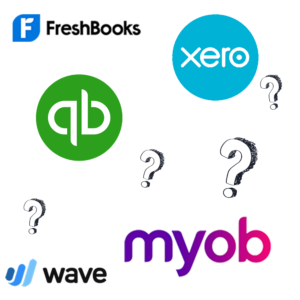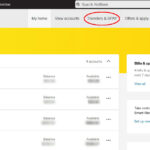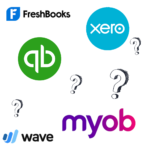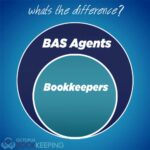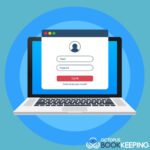Easily track and manage your business finances
Some of us engage bookkeepers to handle our financial records and reports because dealing with numbers is too much of a diversion from our daily tasks. While keeping a distance from the numbers is one good strategy, keeping up with what’s going on in a fast-paced business isn’t always possible without knowing your finances.
Complex business accounting processes are easier to manage with software solutions. Accounting software benefits entrepreneurs by allowing them to manage accounts receivable and payable, gain a clear-cut knowledge of business profitability, and prepare for tax season. Any small company owner can utilise out-of-the-box software without extensive customisation requirements.
There is a wide variety of accounting software that small businesses can choose from, each with its own set of features and price tag. In general, the number of employees and the type of industry is two aspects that might aid a small business owner to select appropriate accounting software. A travel and tour agency, for example, would not require the same accounting software functionality as a retail trade owner.
1: MYOB
- One of the most well-known accounting software brands.
- Accounting plans include BAS and GST statements, payroll, and invoicing.
2: Intuit Quickbooks
- Intuit Quickbooks is the market leader in accounting software.
- Its package features BAS generating, payroll, invoicing, and payment alerts.
- Easy accessibility through a mobile phone or tablet.
- Offers free 30-day trial.
3: Xero
- Offers full support in Australia.
- Starter Pack is perfect for small businesses or solopreneurs.
- Offers free 30-day trial.
- Freshbooks.
- Invoices are simple to create and modify.
- Clients can pay with a credit card with ease.
- Set up reminders for clients who are late with their payments to give them a gentle nudge.
4: Freshbooks
- Invoices are simple to create and modify.
- Clients can pay with a credit card with ease.
- Set up reminders for clients who are late with their payments to give them a gentle nudge.
5: Wave
- Fully integrated software designed for small businesses.
- 100% free.
- Excellent invoice and transaction management.
- It offers software for sale.
- The prices are relatively reasonable, ranging from $8 to $42 each month.
Comparison of Accounting Software Options

1: MYOB
MYOB was founded in Australia, and as a result, it is one of the most well-known accounting brands. It has been operating for a long time, and it offers several solutions to help businesses, bookkeepers and accountants with their accounting needs.
MYOB is more customisable due to various add-ons or integrations since it has various connections with Australian businesses and service providers that are difficult for competitors to match because of its size and popularity in the market.
MYOB’s accounting package includes payroll management, invoicing, reporting, budget management, bank reconciliations, inventory, cash-flow monitoring, and more.
MYOB Essentials Payroll ($10/month) is specifically designed for businesses that need to manage the payroll requirements of employees. In contrast, Essentials Accounting ($48/month) can accomplish a lot more which is excellent for small business and sole traders, while Essential Plus ($109/month) goes even farther. The first three months of subscription to the Accounting or Plus packages are 50% off for new subscribers, and they both enjoy a 30-day trial, whereas the Payroll-only version of MYOB does not.
MYOB is one of the most affordable options for small business that have more than 5 Employees. MYOB Essentials + Payroll and AccountRight have unlimited employees, whereas other software companies may charge per employee over a certain number on the payroll.

2: Intuit QuickBooks
For years, QuickBooks has been a leading name in accounting software. Individuals can choose from a variety of packages and a variety of packages for organisations of various sizes. QuickBooks Self Employed and QuickBooks Online are two of their small business software options. The Self-Employed edition is a cloud-based solution built specifically for self-employed people, while QuickBooks Online is a cloud-based accounting software designed for small businesses.

QuickBooks Self-Employed
QuickBooks Self-Employed is an Intuit solution with a mobile app and a cloud-based internet interface. This program was intended to assist freelancers in staying organised throughout tax season each year. Tracking mileage, classify spending, organising receipts, issuing invoices, and calculating and filing taxes using TurboTax are all features of QuickBooks Self-Employed.
ADVANTAGES
- Cloud-based storage
- Easy access via mobile app
- Tracks mileage
- Distinguishes between business and personal expenses
- Synchronises with TurboTax
DISADVANTAGES
- Difficult transfer of data to other accounting software
- Reporting is limited
- Invoicing functionality and customisation is limited
The mobile app makes it simple to log mileage and take images of receipts for business expenses while driving. Most accounting software does not usually distinguish personal against business transactions, but QuickBooks Self-Employed has a function that allows you to label each transaction as either business or personal. This is useful for freelancers who don’t have a bank account for business.
QuickBooks Self-Employed can be accessed via a desktop computer or a mobile device. There are apps for both iOS and Android that may be used for this. It’s worth mentioning that the QBSE data file from the QuickBooks Self-Employed version cannot be transferred to QuickBooks Online, so they’re not interchangeable in that regard.
The QuickBooks Self Employed bundle includes BAS generating, payroll, invoices, and payment alerts so that you won’t feel confined. It can also generate reports and keep track of receipts. As a result, tracking quarterly business success is entirely possible.
There are three plans to choose from: The Self-Employed plan ($15 per month), the Self-Employed Tax Bundle ($25 per month), and the Self-Employed Live Tax Bundle ($35 per month). For the first three months, QuickBooks offers a 50% discount. A TurboTax subscription for income tax filing is included in both tax bundles. The Self-Employed Live Tax Bundle also includes access to a CPA throughout the year and during tax season to answer inquiries. Before filing, the CPA will also conduct a final review of your tax return in TurboTax.

QuickBooks Online
Small businesses and their bookkeeping and tax specialists have long relied on Intuit’s QuickBooks Online accounting software. The program is hosted in the cloud and accessed via a web browser or a mobile app.
ADVANTAGES
- Scalable
- Commonly used by accounting professionals
- Integration with third-party applications
- Cloud-based storage
- Easy access via mobile app
DISADVANTAGES
- More users need plan upgrade
- Occasional syncing problems with banks and credit cards
Simple Start ($25 per month), Essentials ($40 per month), Plus ($70 per month), and Advanced ($150 per month) are the four membership tiers available after the 30-day free trial. Most bookkeepers offer a significant discount for the first few months, and some bookkeepers can also offer wholesale pricing to small enterprises.
Advanced features such as inventory management, additional users, budgeting, and time tracking are included in each plan. Simple Start plan can cover all of the demands of most service-based small enterprises. In contrast, the Essentials or Plus plans can provide greater inventory and customisation features for product-based small enterprises. The Advanced subscription is a brand-new product that includes Fathom-powered financial reports. Fathom is a high-end online financial report analysis tool utilised by many significant companies throughout the world.
All plans allow for third-party app integration, such as Stripe or PayPal. The app store for QuickBooks Online organises all of their apps by function and includes helpful samples of each app’s benefits.

3: Xero
Xero is the best option for small businesses looking for basic accounting software. This program features a user-friendly interface and a third-party payroll service integration. Through Xero’s integration with Stripe and GoCardless, businesses can accept payments from clients online.
ADVANTAGES
- Payroll integration with Gusto
- Easy access via mobile app
- Cloud-based storage
- Simple inventory management
- Third-party app marketplace
DISADVANTAGES
- Limited reporting
- Limited customer service
Xero was launched in New Zealand in 2006 and today has over two million users throughout the world. In New Zealand, Australia, and the United Kingdom, this accounting software is prevalent. Xero has approximately 3,000 workers and is rapidly expanding in the United States.
Xero offers a 30-day free trial as well as a two-month 50% off promotion. It has three monthly membership packages and a payroll add-on: The Starter Pack ($27/month) includes the most basic business accounting tools and is limited to five bills, five quotes or invoices, reconciliation of 20 bank transactions monthly. It is designed for solopreneurs and small firms with only one owner who does a modest number of high-ticket transactions per month, such as a consultant or small service provider.
The Xero Standard package ($52/month) and the Premium package ($67/month) include bulk reconcile transactions and payroll function for two (Standard) up to five (Premium) people. Invoices, bills, and transactions are unlimited in both the Standard and Premium subscriptions. The sole difference is that the Premium plan includes more multi-currency, spending management, and project costing capabilities. Hubdoc, a bill and receipt capturing tool, is included in all three plans.

4: FreshBooks
Invoicing is the most crucial accounting requirement for most service-based enterprises. In comparison to other accounting software, FreshBooks allows users more invoicing customisations. Its primary capability is to send and print invoices and receive payments, but it may also do basic bookkeeping for a company. FreshBooks makes sending invoices, collecting client retainers, requesting deposits, tracking projects, and receiving payments easier for service-based enterprises.
ADVANTAGES
- Cloud-based storage
- User-friendly dashboard
- Integration with third-party applications
- Affordable price
- Advanced invoicing features
DISADVANTAGES
- No inventory tracking
- Absence of payroll service
- No viewing reports for mobile app
- Limited features for larger businesses
FreshBooks began as a simple invoicing software in Toronto in 2003. More features have been developed over time, and FreshBooks today employs over 500 people. There are four different plans to choose from, and corporations can save 10% by paying yearly rather than monthly. FreshBooks also offers a monthly discount of 60% for six months. The four plans are: Lite ($6/month), Plus ($10/month), Premium ($20/month), and Select ($20/month). Select is a personalised service with custom pricing.
The number of clients who can be billed per month is the main difference between the four tiers. Despite unlimited invoicing, you can only store a maximum of 5 clients in the address book at a time without increasing your plan. Up to five clients can be billed each month on the Lite plan, but more than enough for start-up businesses or new freelancers. You can upgrade your package to support between 50 and 500 clients as your business grows and your customer base expands. The Plus package allows you to bill up to 50 clients each month. Unlimited clients can be billed per month on both the Premium and Select plans, although the latter has some unique features. FreshBooks costs an additional $10 per month for numerous team members, and the advanced payment option costs an additional $20 per month. It allows users to charge a credit card in real-time or set up a recurring credit card charge for a specific amount.
Shopify, Gusto, Stripe, G Suite, and other third-party app connectors integrated with FreshBooks. FreshBooks invoicing software is simple to use and does not place any restrictions on the user. FreshBooks invoices may be highly personalised and adjusted for a professional look and feel, a unique feature. FreshBooks is a fantastic tool for planning tasks, sending estimates and bids, and collecting payments from customers. FreshBooks can be used on any device and allows you to produce customised receipts while on the road quickly.
Other invoicing features include:
- Smartphone camera integration enables receipt imaging and expense recording in real-time.
- Schedule recurring invoices to be generated at the same time.
- Set up reminders for clients who are late with their payments to offer them a gentle nudge.
- With the option to automate late fines, you can stay on top of late payments.
- Clients can conveniently pay using a credit card right on the invoice.
FreshBooks can do more than generate and send invoices; it can also track your total expenses. On the finance dashboard, you can see revenue generated, expenses, and profit brought in. You may easily filter out findings to include a comparison study over a specific period.

5: Wave
NOTE: Australia has one of the most complex Taxation Systems in the world. Wave Accounting has a lot of components, but not all of them are compliant with ATO complex Payroll, GST, and Taxation. This article is designed as a solution for Invoicing for micro and freelance businesses only. If you are running small or larger business in Australia, please get professional advice on what kind of software will be more suitable for your company needs. Just give us a call, we are helping hundreds of SMEs to be efficient and ATO compliant.
Wave is an excellent accounting platform for a service-based small firm that doesn’t need to maintain inventory or run payroll. Wave’s free features will handle all of a freelancer’s or service-based business’ accounting needs, making it the top free software in our evaluation. Accountants can get the essential information from Wave at year’s end to construct a business plan.
ADVANTAGES
- Free accounting, invoicing, and receipt scanning
- Easy access via mobile app
- No transaction or billing limits
- Run multiple businesses in one account
- Unlimited number of users
DISADVANTAGES
- Limited full-service payroll solution
- Higher fees for credit cards and Automated Clearing Houses (ACH) payments
- No inventory management
- Limited third-party app integrations
Wave is a Toronto-based company that was launched in 2010. H&R Block just purchased the company, which employs over 250 people. This free accounting software includes the essential accounting tools that most small businesses require, such as income and cost management, financial reporting, invoicing, and receipt scanning. These functions are available both online and through the mobile app. Payroll and customer payment processing are viewed as premium services that incur additional fees, while all bookkeeping, invoicing, and reporting functions are available for free.
Although most accounting features are free of use, Wave’s customer payment processing is not free. This accounting software charges 3.4% plus 30¢ per American Express transaction and 2.9% plus 30¢ per Mastercard, Visa, and Discover transaction to process customer payment. These fees are relatively higher than other accounting software. Wave also charges 1% for every transaction with a $1 minimum cost to handle an ACH payment rather than a credit card, which is Wave’s unique feature.
As an add-on service, Wave offers two payroll plans. The initial plan is $20 per month plus an additional $6 per employee or contractor. Wave will handle payroll and calculate payroll taxes under this plan, but the user will be responsible for manually filling out payroll tax forms and sending tax payments. The second plan is $35 per month plus $6 for each employee or contractor, including full-service payroll. This means that Wave handles all tax filings and payments, but only 14 states (USA) provide this full-service payroll solution.
FAQs
What Does Small Business Accounting Software Do?
Accounting software allows customers to integrate their corporate bank accounts and credit cards with the software, which cuts down on data entry time. Transactions will flow into the accounting software once they have been synced, where they can be sorted into various accounts. While most accounting software is simple to use, a basic understanding of accounting principles is required to ensure that financial statements are accurate. As a result, many businesses use bookkeepers or accountants to keep track of their records or examine them.
Accounting software for small businesses has the following basic features:
- Invoicing
- Bank and credit card syncing
- Accounts payable
- Accounts receivable
- Payroll
- Cash management
- Bills payment
- Online payment collection from customers
- Basic financial statement preparation, such as balance sheets, profit or loss and cash flow
- Remote access for bookkeepers or tax professionals
Accounting software is usually broken down into several pieces; this prevents the software from becoming overly complicated with capabilities that aren’t required. It also keeps you from spending too much for too many features in single complicated accounting software that you never use.
While most of these programs include a profit and loss statement, larger organisations will want the advanced versions for more extensive reporting and other capabilities. Starting simple and scaling up to more powerful packages as demands emerge is possible. It’s common for buyers to put off utilising accounting software until later, so don’t make that mistake.
How Does Accounting Software Work?
Transactions will show in a queue once a business’ bank accounts and credit cards have been synchronised with the accounting software, and they can be sorted into the categories found on the chart of accounts. Following the selection of the appropriate category, transactions begin to populate the financial accounts of the company. In seconds, business managers may analyse profitability, compare revenue and costs, verify bank and loan balances, and forecast tax liabilities by running a financial report. Having instant access to this financial data empowers business leaders to make critical decisions.
In addition, several accounting software packages allow for the integration of third-party applications. For example, suppose a business owner utilises a point of sale (POS) system to capture sales transactions. In that case, the POS system and accounting software might combine to record individual sale transactions, sales by subcategories, sales tax liabilities, and more. A time tracking program could be integrated with accounting software to add labour to a client invoice in a service-based business.
How Often Should You Back Up Accounting Software?
The majority of accounting software packages today are cloud-based or have a mobile app. The synchronisation of data between apps or web browsers and the cloud reduces the likelihood of a severe data loss.
A backup procedure must still be carried out to prevent data loss. Your personal preferences determine the frequency with which you back up your accounting data. Depending on how big of a disaster it will be to restore an older backup and recreate the accounting data added afterwards, we would recommend anywhere between daily and weekly backups.
How Much Does Small Business Accounting Software Cost?
The monthly cost of small business accounting software ranges from $0 to $150. Excellent basic plans cost from $0 up to $40 monthly, and they are perfect for a start.
A small firm can organise income and costs, send invoices, and produce financial reports with a basic strategy. Most software is scalable as the business grows, and the plan may be instantly upgraded to meet new business needs. Business owners can monitor inventory, run payroll, choose from additional invoicing choices, and create customised financial reports with premium plans.
Which Accounting Software is Best for You?
Despite their similarities, each accounting platform has its own set of advantages and capabilities. Some are designed for small business owners, while others are optimised for more established businesses.
In choosing the best accounting software for your business, consider whether you might be able to upgrade from one package to another, although that isn’t always the case. Also, selecting appropriate plans to meet all the desired functionality will differ depending on the accounting software provider. As a result, they’re unlikely to be directly comparable. Thus, even if the accounting features perfectly matches what you need, price isn’t the only factor to consider.
Choose wisely if you want to prevent switching to different accounting platforms later on. Upgrading your plan through the same provider is one thing you need to consider while switching to an entirely new platform may be inconvenient.

